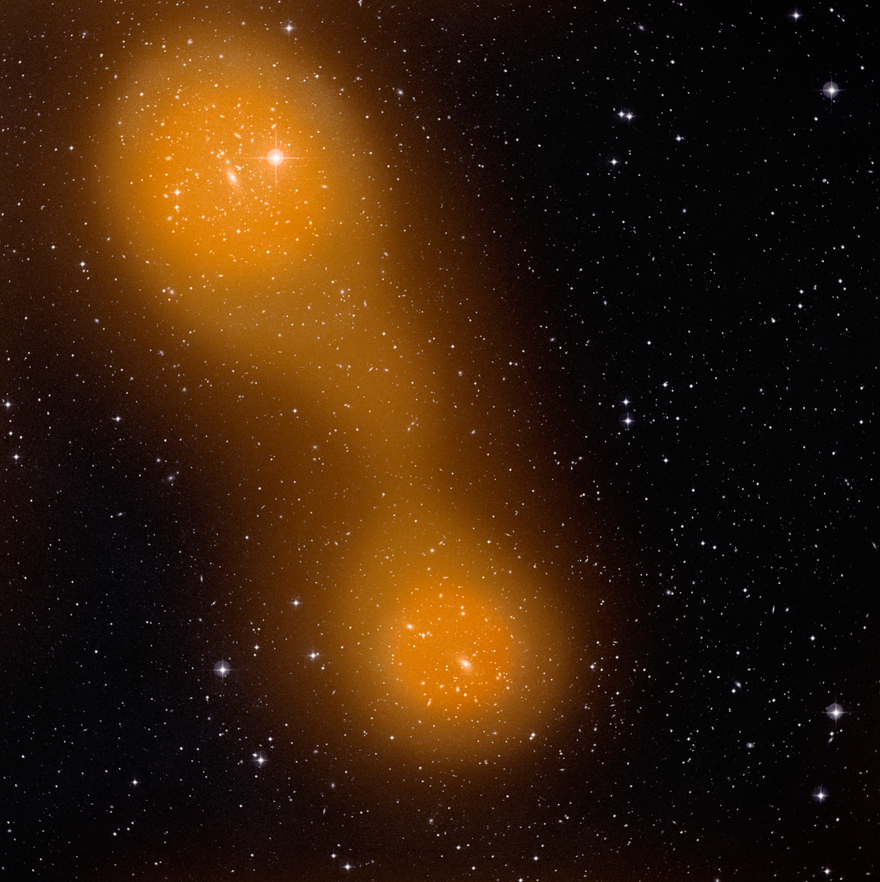Planck Space Telescope spots hot gas bridging galaxy cluster pair

Galaxy clusters connected by gas bridge (Credit: European Space Agency)
November 21, 2012
The Planck Space Telescope has made the first conclusive detection of a bridge of hot gas connecting a pair of galaxy clusters across 10 million light-years of intergalactic space.
Planck's primary task is to capture the most ancient light of the cosmos, the Cosmic Microwave Background, or CMB. As this faint light traverses the Universe, it encounters different types of structure including galaxies and galaxy clusters – assemblies of hundreds to thousands of galaxies bound together by gravity.
If the CMB light interacts with the hot gas permeating these huge cosmic structures, its energy distribution is modified in a characteristic way, a phenomenon known as the Sunyaev–Zel'dovich (SZ) effect, after the scientists who discovered it.
This effect has already been used by Planck to detect galaxy clusters themselves, but it also provides a way to detect faint filaments of gas that might connect one cluster to another.
In the early Universe, filaments of gaseous matter pervaded the cosmos in a giant web, with clusters eventually forming in the densest nodes.
Much of this tenuous, filamentary gas remains undetected, but astronomers expect that it could most likely be found between interacting galaxy clusters, where the filaments are compressed and heated up, making them easier to spot.
Planck's discovery of a bridge of hot gas - on the order of 80 million degrees Celsius - connecting the clusters Abell 399 and Abell 401, each containing hundreds of galaxies, represents one such opportunity. It also marks Planck's first detection of inter-cluster gas using the SZ effect technique.
Early analysis suggests the gas could be mixture of the elusive filaments of the cosmic web mixed with gas originating from the clusters.
A more detailed analysis and the possible detection of gas bridges connecting other clusters will help to provide a more conclusive answer.
The new finding highlights the ability of Planck to probe galaxy clusters to their outskirts and beyond, examining their connection with the gas that permeates the entire Universe and from which all groups of galaxies formed.
The Canadian Connection
The concept of the Cosmic Web was first described in 1996 by Canadian astrophysicists Drs J. Richard Bond, Lev Kofman and Dmitry Pogosyan. Professor Bond, currently leads the Canadian High Frequency Instrument (HFI) team (one of the two instruments Canada contributed to the Planck Space Telescope through funding from the Canadian Space Agency (CSA).
"When we developed the theory of the cosmic web in the mid-nineties, in which filaments of matter played the fundamental role of bridging the space between the most massive entities in the Universe, clusters of galaxies, and ultimately drawing them together in major merger events, one of the first observable applications was these filaments as seen through gravitational lensing," says Professor Bond of the Canadian Institute for Theoretical Astrophysics in Toronto. "Our new Planck results are very exciting, for the first time seeing in the cosmic microwave radiation the imprint of the hot gas in the filaments as the clusters approach each other to eventually merge."
"When the idea of the Cosmic Web was first described by Drs Bond, Kofman and Pogosyan, it was like an epiphany! Suddenly we had a clear explanation for how the Universe formed structures -- and why it seemed like smaller things grow into larger things at the same time that larger things flow into smaller things," notes Professor Douglas Scott of the University of British Columbia, who leads the Canadian Low Frequency Instrument (LFI) team—Canada's second contribution to the Planck mission. "The Cosmic Web picture explained this paradox. So it's exciting to see clear new evidence supporting this picture through the detection of a filament of hot gas," adds Professor Scott.
-With material courtesy of the European Space Agency (ESA).